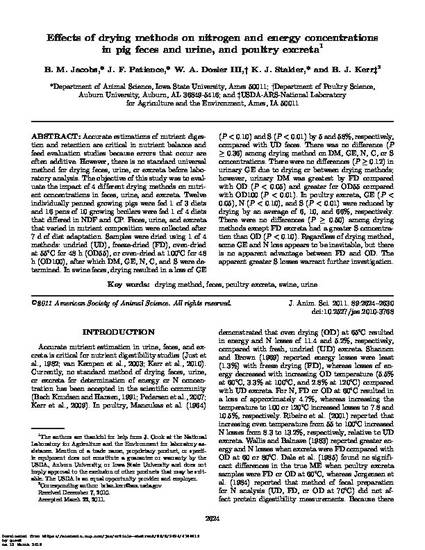
Accurate estimations of nutrient digestion and retention are critical in nutrient balance and feed evaluation studies because errors that occur are often additive. However, there is no standard universal method for drying feces, urine, or excreta before laboratory analysis. The objective of this study was to evaluate the impact of 4 different drying methods on nutrient concentrations in feces, urine, and excreta. Twelve individually penned growing pigs were fed 1 of 3 diets and 16 pens of 10 growing broilers were fed 1 of 4 diets that differed in NDF and CP. Feces, urine, and excreta that varied in nutrient composition were collected after 7 d of diet adaptation. Samples were dried using 1 of 4 methods: undried (UD), freeze-dried (FD), oven-dried at 55°C for 48 h (OD55), or oven-dried at 100°C for 48 h (OD100), after which DM, GE, N, C, and S were determined. In swine feces, drying resulted in a loss of GE (P < 0.10) and S (P < 0.01) by 5 and 58%, respectively, compared with UD feces. There was no difference (P ≥ 0.36) among drying method on DM, GE, N, C, or S concentrations. There were no differences (P ≥ 0.12) in urinary GE due to drying or between drying methods; however, urinary DM was greatest by FD compared with OD (P < 0.05) and greater for OD55 compared with OD100 (P < 0.01). In poultry excreta, GE (P < 0.05), N (P < 0.10), and S (P < 0.01) were reduced by drying by an average of 6, 10, and 66%, respectively. There were no differences (P ≥ 0.50) among drying methods except FD excreta had a greater S concentration than OD (P < 0.10). Regardless of drying method, some GE and N loss appears to be inevitable, but there is no apparent advantage between FD and OD. The apparent greater S losses warrant further investigation.
Available at: http://works.bepress.com/john-patience/31/

This article is published as Jacobs, B. M., J. F. Patience, W. A. Dozier 3rd, K. J. Stalder, and B. J. Kerr. "Effects of drying methods on nitrogen and energy concentrations in pig feces and urine, and poultry excreta." Journal of animal science 89, no. 8 (2011): 2624. doi: 10.2527/jas.2010-3768.